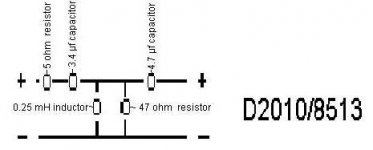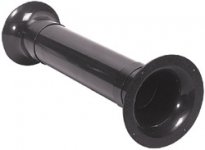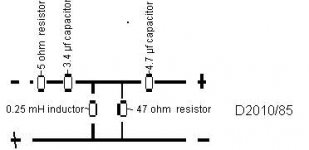I've been using my Aleph 30 with my ProAc clones (almost explicitly). 30W into these speakers is plenty in my livingroom (4x5 meters2). Right now I'm laborating with different biasing and such, though I'm in the process of building a better pre amp.
Once you get started, you realize that the amp and the speakers you've just built are so much better than the rest of your system.
//magnus
Once you get started, you realize that the amp and the speakers you've just built are so much better than the rest of your system.
//magnus
What is the real power rating of Proac 2.5 project?
I have read on Proac factory web page, that they recommend amplifier power from 20 - 200W, but the Scan-speak bass-mid driver got only 70W RMS. Is this the same driver used in original Proac response 2.5?
Thanks, Supernet
I have read on Proac factory web page, that they recommend amplifier power from 20 - 200W, but the Scan-speak bass-mid driver got only 70W RMS. Is this the same driver used in original Proac response 2.5?
Thanks, Supernet
Les, Check out these sites for info on the P3A:
http://sound.westhost.com/project3a.htm
http://www.anidian.com/audio/construct/p3a_1.shtml
Also search the forum. You’ll find plenty of info. And good luck with your proac’s
Swede, thanks for the reply. I’ll second that with 30 watts plenty. I only have 25 watts now, and I achieve a decent listening level with the volume at 9-10 a clock. Actually I never had the volume past 11 a clock. So if I do build an aleph it will probably be 30.
http://sound.westhost.com/project3a.htm
http://www.anidian.com/audio/construct/p3a_1.shtml
Also search the forum. You’ll find plenty of info. And good luck with your proac’s
Swede, thanks for the reply. I’ll second that with 30 watts plenty. I only have 25 watts now, and I achieve a decent listening level with the volume at 9-10 a clock. Actually I never had the volume past 11 a clock. So if I do build an aleph it will probably be 30.
Swede: If I understand you correct then you just have switched the cable between the amp and biwire terminal at the speakers so that you place the + cable from the amp in the - on the terminal etc.
I am not sure that this is how jacq explain the polarity issue or at least it's not how I have understood it. Though I could be wrong or perhaps I just have misunderstood you. I will attach a little drawing that shows how I have understood the polarity issue because that's easier than explaning.
I am not sure that this is how jacq explain the polarity issue or at least it's not how I have understood it. Though I could be wrong or perhaps I just have misunderstood you. I will attach a little drawing that shows how I have understood the polarity issue because that's easier than explaning.
Attachments
Now I have been reading another place about the polarity issue and gotten even more confused. I thought I had it right but now I don't know. If someone please could common on the drawing I have attached at my earlier post. I am thinking about the + and - in both ends and the layout of the parts in the xo.
Seve
Seve
flange around the port
Hi,
on http://www.geocities.com/diyproac25/ I read the following:
"with internal flange placed at the port end inside the cabinet to reduce turbulence (use either 100 x 100mm square MDF or PVC pipe flange)"
and
"single 150mm wide brace around the port"
Can somebody explain me what they mean?
Saci
Hi,
on http://www.geocities.com/diyproac25/ I read the following:
"with internal flange placed at the port end inside the cabinet to reduce turbulence (use either 100 x 100mm square MDF or PVC pipe flange)"
and
"single 150mm wide brace around the port"
Can somebody explain me what they mean?
Saci
Seve
From your drawing, change the left hand side +ve & -ve around (+ve on bottom and -ve on top) . And use Jacq's crossover modifications.
Saci
It is difficult to explain port flange/flare in all the languages of the world even though it is very simple to observe. May I suggest you visit an audio shop and observe the differences between subwoofer ports in different designs. Some will have flared/rounded port ends. Now imagine this at both ends of the port (inside box and outside), and copy it for the 2.5 clone.
Port flaring is not that important in my opinion as it is difficult to hear port noises in this speaker design.
Once again everyone, may I suggest you keep things simple for yourself and follow the basic plan on the website. There are minor suggestions to improve things, but if you don't understand them do not worry, you will not be able to hear the difference in most situations, and save your mental energy for more useful things to complete the project.
Al.M
From your drawing, change the left hand side +ve & -ve around (+ve on bottom and -ve on top) . And use Jacq's crossover modifications.
Saci
It is difficult to explain port flange/flare in all the languages of the world even though it is very simple to observe. May I suggest you visit an audio shop and observe the differences between subwoofer ports in different designs. Some will have flared/rounded port ends. Now imagine this at both ends of the port (inside box and outside), and copy it for the 2.5 clone.
Port flaring is not that important in my opinion as it is difficult to hear port noises in this speaker design.
Once again everyone, may I suggest you keep things simple for yourself and follow the basic plan on the website. There are minor suggestions to improve things, but if you don't understand them do not worry, you will not be able to hear the difference in most situations, and save your mental energy for more useful things to complete the project.
Al.M
fcel,
Right. The veneer comes on as the last thing (not counting oil of course) and covers all of the wood filler (plaster stuff) marks and joints and things (and all the scibbling done to remember what is up, front, back and so on). In this case it is 1 mm American Cherry Veneer. The actual enclosure is made according to specs at the clone page and it is standard MDF so no grains there.
/UrSv
Right. The veneer comes on as the last thing (not counting oil of course) and covers all of the wood filler (plaster stuff) marks and joints and things (and all the scibbling done to remember what is up, front, back and so on). In this case it is 1 mm American Cherry Veneer. The actual enclosure is made according to specs at the clone page and it is standard MDF so no grains there.
/UrSv
Al.M
Thanks a lot for clearing up my confussion. Also a thanks for you making this speaker possible by your homepage.
I am planing to use the modified xo by jecq, but it's only the woofer part that is modified is it not?
I will attach the tweeter again to be totally sure that I am right this time
Thanks a lot for clearing up my confussion. Also a thanks for you making this speaker possible by your homepage.
I am planing to use the modified xo by jecq, but it's only the woofer part that is modified is it not?
I will attach the tweeter again to be totally sure that I am right this time
Attachments
Saci
Thats it (the flared port); was not hard at all. The brace you can leave it at your grandmother's house or put it inside the speaker.
Gaber
Technically (Loudspeaker design Cookbook by Vance Dickason, 1997, 1000th edition?) you need a round-over of at least 50mm diameter or something very large before audible and measurable diffraction difference can be seen or heard, otherwise it is not significant. Thats why so many commercially famous speakers without rounded edges still sound great.
Seve
I think it is time to start building the speaker before your mental energy is totally wasted. Jacq says to modify the woofer crossover, have you read the website.
Sorry guys I am not trying to be rude. We will try to make the website clearer for some, but most people find it OK to follow.
Thats it (the flared port); was not hard at all. The brace you can leave it at your grandmother's house or put it inside the speaker.
Gaber
Technically (Loudspeaker design Cookbook by Vance Dickason, 1997, 1000th edition?) you need a round-over of at least 50mm diameter or something very large before audible and measurable diffraction difference can be seen or heard, otherwise it is not significant. Thats why so many commercially famous speakers without rounded edges still sound great.
Seve
I think it is time to start building the speaker before your mental energy is totally wasted. Jacq says to modify the woofer crossover, have you read the website.
Sorry guys I am not trying to be rude. We will try to make the website clearer for some, but most people find it OK to follow.
Al.M
Yes I have read your homepage about the proac clone. I have actually read it many times. Overall I like it very much it gives you some ideas about how to start the project though If I was you I would be more precis about the tweeter placement(thinking about the difference in the cad and text) and also would I explain the polarity issue better. The things I would change if I was you is mentioned because they would be helpful to me but others could find them not necessary.
I could probably have started earlier building the speaker but because my knowledge level about DIY speakers is rather limited I wanted to be sure I understood everything before doing something stupid. It is simply because I want to be sure I hope I have not annoyed you to much.
The reason why I asked about if the woofer was the only to be modified was because of your earlier post where you commented my drawing and said to use the modified xo and I was not sure if you were refering to some changes I did not know about in the tweeter or just the well known woofer modifications. Now I know.....thanks.
Seve
Yes I have read your homepage about the proac clone. I have actually read it many times. Overall I like it very much it gives you some ideas about how to start the project though If I was you I would be more precis about the tweeter placement(thinking about the difference in the cad and text) and also would I explain the polarity issue better. The things I would change if I was you is mentioned because they would be helpful to me but others could find them not necessary.
I could probably have started earlier building the speaker but because my knowledge level about DIY speakers is rather limited I wanted to be sure I understood everything before doing something stupid. It is simply because I want to be sure I hope I have not annoyed you to much.
The reason why I asked about if the woofer was the only to be modified was because of your earlier post where you commented my drawing and said to use the modified xo and I was not sure if you were refering to some changes I did not know about in the tweeter or just the well known woofer modifications. Now I know.....thanks.
Seve
Hey folks. My own Proac 2.5 boxes are just about done...have to post some pics next week. (unfortunately I cannot take credit for the woodwork)
Question--the tweeters stick out of the baffle slightly less than the thickness of two sheets of paper. Is this enough to cause problems?
Question--the tweeters stick out of the baffle slightly less than the thickness of two sheets of paper. Is this enough to cause problems?
Finally finished my pair of clones. Me and Swede made a pair each and the only difference was that I used somewhat better components. Nothing special but MCaps, Mundorf BL coils and MOX resistors. I just wanted a good start and now the tweaking will start and I will most likely try the 7 uF/1.8 mH mod. Later.
A note on the sound of these in their VERY early life before break-in.
Bass:
Somewhat flappy ( know it gets better from Swede's pair) but nice and clean with surprising low-end extension for the 7".
Mid-range:
Slightly curtained now but this will get better with time (Swede's pair...). Played Diane Schuur, Vollenweider, Pat Coil and Acoustic Alchemy. Very nice on piano already and vocals are natural.
Treble:
Crisp yet naturally soft and very enjoyable. Expecting perhaps a little more detail after break-in.
Summary:
At EUR 480 total they are already a great bargin and they will really come to life after some 100+ hours of break-in. They are by far the best speakers I have had (previous owned favourite was Snell EIII) and they will only get better. No need to hesitate in building a pair of these...
My special treatment (Dice?):
All mounting material is non-magnetic from enclosure to filters. Brass and Stainless steel throughout.
/UrSv
A note on the sound of these in their VERY early life before break-in.
Bass:
Somewhat flappy ( know it gets better from Swede's pair) but nice and clean with surprising low-end extension for the 7".
Mid-range:
Slightly curtained now but this will get better with time (Swede's pair...). Played Diane Schuur, Vollenweider, Pat Coil and Acoustic Alchemy. Very nice on piano already and vocals are natural.
Treble:
Crisp yet naturally soft and very enjoyable. Expecting perhaps a little more detail after break-in.
Summary:
At EUR 480 total they are already a great bargin and they will really come to life after some 100+ hours of break-in. They are by far the best speakers I have had (previous owned favourite was Snell EIII) and they will only get better. No need to hesitate in building a pair of these...
My special treatment (Dice?):
All mounting material is non-magnetic from enclosure to filters. Brass and Stainless steel throughout.
/UrSv
Swede,
They are playing even as I post this...
Now up to about 10 hours and they already have tightened up the bass a bit. I will have to wait but I can see the 7 uF/1.8 mH mod being likely to happen. Just ripped the guts out of my Zen R to give room for the A30 to drive the clones. Can't wait.
/UrSv
They are playing even as I post this...
Now up to about 10 hours and they already have tightened up the bass a bit. I will have to wait but I can see the 7 uF/1.8 mH mod being likely to happen. Just ripped the guts out of my Zen R to give room for the A30 to drive the clones. Can't wait.
/UrSv
- Status
- This old topic is closed. If you want to reopen this topic, contact a moderator using the "Report Post" button.
- Home
- Loudspeakers
- Multi-Way
- Pics of my diy proac 2.5 "clones"


